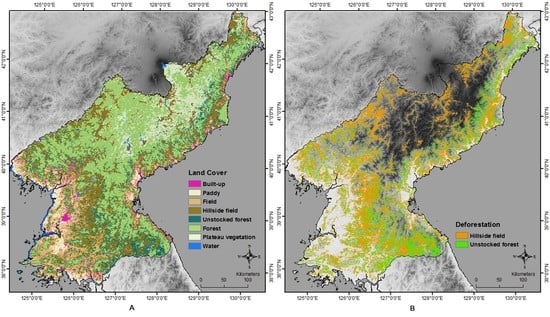Mapping Deforestation in North Korea Using Phenology-Based Multi-Index and Random Forest
Abstract
:1. Introduction
2. Study Area
3. Materials and Methods
3.1. MODIS Data Collection
Processing of Time Series Data
3.2. Reference Data Collection
3.2.1. Training Samples Collection
3.2.2. Test Samples Collection
3.3. Normalized Indices
3.4. Classification Algorithm Using RF and Validation
4. Results and Discussion
4.1. Temporal Indices of Land Cover Classes
4.2. Temporal Indices of Land Cover Classes and Relevant Variables in the RF Classification
4.3. Classification Result and Accuracy Assessment
5. Conclusions
Acknowledgments
Author Contributions
Conflicts of Interest
References
- Millennium Ecosystem Assessment (MEA). Ecosystems and Human Well-Being: Scenarios; Millennium Ecosystem Assessment: Washington, DC, USA, 2005. [Google Scholar]
- Abood, S.A.; Lee, J.S.H.; Burivalova, Z.; Garcia-Ulloa, J.; Koh, L.P. Relative contributions of the logging, fiber, oil palm, and mining industries to forest loss in Indonesia. Conserv. Lett. 2015, 8, 58–67. [Google Scholar] [CrossRef]
- Sasaki, N.; Putz, F.E. Critical need for new definitions of “forest” and “forest degradation” in global climate change agreements. Conserv. Lett. 2009, 2, 226–232. [Google Scholar] [CrossRef]
- Zheng, D.; Wallin, O.D.; Hao, Z. Rates and patterns of landscape change between 1972 and 1988 in the Changbai Mountain area of China and North Korea. Landsc. Ecol. 1997, 12, 241–254. [Google Scholar] [CrossRef]
- Bhatia, R.; Thorne-Lyman, A.L. Food shortages and nutrition in North Korea. Lancet 2002, 360, s27–s28. [Google Scholar] [CrossRef]
- Tang, L.; Shao, G.; Piao, Z.; Dai, L.; Jenkins, M.A.; Wang, S.; Wu, G.; Wu, J.; Zhao, J. Forest degradation deepens around and within protected areas in East Asia. Biol. Conserv. 2010, 143, 1295–1298. [Google Scholar] [CrossRef]
- Chazdon, R.L. Beyond deforestation: Restoring forests and ecosystem services on degraded lands. Science 2008, 320, 1458–1460. [Google Scholar] [CrossRef] [PubMed]
- Wilson, E.H.; Sader, S.A. Detection of forest harvest type using multiple dates of Landsat TM imagery. Remote Sens. Environ. 2002, 80, 385–396. [Google Scholar] [CrossRef]
- Cha, S.; Park, C.H. The utilization of google earth images as reference data for the multitemporal land cover classification with MODIS data of North Korea. Korean J. Remote Sens. 2007, 23, 483–491. [Google Scholar]
- Gómez, C.; White, J.C.; Wulder, M.A. Optical remotely sensed time series data for land cover classification: A review. ISPRS J. Photogramm. Remote Sens. 2016, 116, 55–72. [Google Scholar] [CrossRef]
- Souza, J.C.; Siqueira, J.; Sales, M.; Fonseca, A.; Ribeiro, J.; Numata, I.; Cochrane, M.; Barber, C.; Roberts, D.; Barlow, J. Ten-year landsat classification of deforestation and forest degradation in the Brazilian Amazon. Remote Sens. 2013, 5, 5493–5513. [Google Scholar] [CrossRef]
- Adam, E.; Mutanga, O.; Odindi, J.; Abdel-Rahman, E.M. Land-use/cover classification in a heterogeneous coastal landscape using rapideye imagery: Evaluating the performance of random forest and support vector machines classifiers. Int. J. Remote Sens. 2014, 35, 3440–3458. [Google Scholar] [CrossRef]
- Grimm, R.; Behrens, T.; Märker, M.; Elsenbeer, H. Soil organic carbon concentrations and stocks on barro colorado island—Digital soil mapping using random forests analysis. Geoderma 2008, 146, 102–113. [Google Scholar] [CrossRef]
- Baccini, A.; Goetz, S.J.; Walker, W.S.; Laporte, N.T.; Sun, M.; Sulla-Menashe, D.; Hackler, J.; Beck, P.S.A.; Dubayah, R.; Friedl, M.A.; et al. Estimated carbon dioxide emissions from tropical deforestation improved by carbon-density maps. Nat. Clim. Chang. 2012, 2, 182–185. [Google Scholar] [CrossRef]
- Clark, M.L.; Aide, T.M.; Grau, H.R.; Riner, G. A scalable approach to mapping annual land cover at 250 m using MODIS time series data: A case study in the dry chaco ecoregion of South America. Remote Sens. Environ. 2010, 114, 2816–2832. [Google Scholar] [CrossRef]
- Clerici, N.; Weissteiner, C.J.; Gerard, F. Exploring the use of MODIS NDVI-based phenology indicators for classifying forest general habitat categories. Remote Sens. 2012, 4, 1781–1803. [Google Scholar] [CrossRef]
- Eisavi, V.; Homayouni, S.; Yazdi, A.M.; Alimohammadi, A. Land cover mapping based on random forest classification of multitemporal spectral and thermal images. Environ. Monit. Assess. 2015, 187, 291. [Google Scholar] [CrossRef] [PubMed]
- Senf, C.; Pflugmacher, D.; van der Linden, S.; Hostert, P. Mapping rubber plantations and natural forests in Xishuangbanna (Southwest China) using multi-spectral phenological metrics from MODIS time series. Remote Sens. 2013, 5, 2795–2812. [Google Scholar] [CrossRef]
- Gartzia, M.; Alados, C.L.; Pérez-Cabello, F.; Bueno, C.G. Improving the accuracy of vegetation classifications in mountainous areas. Mt. Res. Dev. 2013, 33, 63–74. [Google Scholar] [CrossRef]
- Franklin, S.E.; Connery, D.R.; Williams, J.A. Classification of alpine vegetation using Landsat thematic mapper SPOT HRV and DEM data. Can. J. Remote Sens. 1994, 20, 49–58. [Google Scholar]
- Dymond, C.C.; Mladenoff, D.J.; Radeloff, V.C. Phenological differences in tasseled cap indices improve deciduous forest classification. Remote Sens. Environ. 2002, 80, 460–472. [Google Scholar] [CrossRef]
- Cha, S.; Seo, D.; Park, C. Monitoring vegetation phenology using MODIS in Northern Plateau region, North Korea. Korean J. Remote Sens. 2009, 25, 399–409. [Google Scholar]
- Schoene, D.; Killmann, W.; Lüpke, H.v.; LoycheWilkie, M. Definitional Issues Related to Reducing Emissions from Deforestation in Developing Countries; Food and Agriculture Organization of the United Nations: Rome, Italy, 2007. [Google Scholar]
- Land-Cover and Land-Use Change Program (LCLUC). Deforestation in North Korea. Available online: http://lcluc.umd.edu/hotspot/deforestation-north-korea (accessed on 2 January 2016).
- Thompson, I.D.; Guariguata, M.R.; Okabe, K.; Bahamondez, C.; Nasi, R.; Heymell, V.; Sabogal, C. An operational framework for defining and monitoring forest degradation. Ecol. Soc. 2013, 18, 20. [Google Scholar] [CrossRef]
- USGS Earth Explorer. Available online: http://earthexplorer.usgs.gov/ (accessed on 2 February 2016).
- Jensen, J.R.; Cowen, D.C. Remote Sensing of Urban/Suburban Socio-Economic Attributes. In Proceedings Land Satellite Information in the Next Decade II; American Society for Photogrammetry & Remote Sensing: Bethesda, MD, USA, 1997. [Google Scholar]
- Yool, S.R.; Makaio, M.J.; Watts, J.M. Techniques for computer-assisted mapping of rangeland change. J. Range Manag. 1997, 50, 307–314. [Google Scholar] [CrossRef]
- Jönsson, P.; Eklundh, L. Timesat—A program for analyzing time-series of satellite sensor data. Comput. Geosci. 2004, 30, 833–845. [Google Scholar] [CrossRef]
- Eklundh, L.; Jönsson, P. Timesat 3.2 Software Manual; Lund and Malmö University: Lund, Sweden, 2015. [Google Scholar]
- Viovy, N.; Arino, O.; Belward, A.S. The best index slope extraction (BISE)—A method for reducing noise in NDVI time-series. Int. J. Remote Sens. 1992, 13, 1585–1590. [Google Scholar] [CrossRef]
- Gutman, G.G. Monitoring land ecosystems using the NOAA global vegetation index data set. Glob. Planet Chang. 1991, 90, 195–200. [Google Scholar] [CrossRef]
- Holben, B.N. Characteristics of maximum-value composite images from temporal AVHRR data. Int. J. Remote Sens. 1986, 7, 1417–1434. [Google Scholar] [CrossRef]
- Lloyd, D. A phenological classification of terrestrial vegetation cover using shortwave vegetation index imagery. Int. J. Remote Sens. 1990, 11, 2269–2279. [Google Scholar] [CrossRef]
- Reed, B.C.; Brown, J.F.; Vanderzee, D.; Loveland, T.R.; Merchant, J.W.; Ohlen, D.O. Measuring phenological variability from satellite imagery. J. Veg. Sci. 1994, 5, 703–714. [Google Scholar] [CrossRef]
- Sellers, P.J.; Tucker, C.J.; Collatz, G.J.; Los, S.O.; Justice, C.O.; Dazlich, D.A.; Randall, D.A. A global 1-degrees by 1-degrees NDVI data set for climate studies. 2. The generation of global fields of terrestrial biophysical parameters from the NDVI. Int. J. Remote Sens. 1995, 16, 1571. [Google Scholar]
- Jonsson, P.; Eklundh, L. Seasonality extraction by function fitting to time-series of satellite sensor data. IEEE Trans. Geosci. Remote 2002, 40, 1824–1832. [Google Scholar] [CrossRef]
- Google Earth. Available online: https://www.google.com/earth/ (accessed on 15 August 2015).
- Hu, Q.; Wu, W.; Xia, T.; Yu, Q.; Yang, P.; Li, Z.; Song, Q. Exploring the use of google earth imagery and object-based methods in land use/cover mapping. Remote Sens. 2013, 5, 6026–6042. [Google Scholar] [CrossRef]
- Ye, Y.; Wu, Q.; Huang, J.Z.; Ng, M.K.; Li, X. Stratified sampling for feature subspace selection in random forests for high dimensional data. Pattern Recognit. 2013, 46, 769–787. [Google Scholar] [CrossRef]
- Li, C.; Wang, J.; Wang, L.; Hu, L.; Gong, P. Comparison of classification algorithms and training sample sizes in urban land classification with landsat thematic mapper imagery. Remote Sens. 2014, 6, 964–983. [Google Scholar] [CrossRef]
- Congalton, R.G.; Green, K. Assessing the Accuracy of Remotely Sensed Data: Principles and Practices, 2nd ed.; CRC Press: Boca Raton, FL, USA, 2009. [Google Scholar]
- Simonetti, E.; Simonetti, D.; Preatoni, D. Phenology-Based Land Cover Classification Using Landsat 8 Time Series; European Commission Joint Research Center: Ispra, Italy, 2014. [Google Scholar]
- Takeuchi, W.; Yasuoka, Y. Development of normalized vegetation, soil and water indices derived from satellite remote sensing data. J. Jpn. Soc. Photogramm. Remote Sens. 2004, 43, 7–19. [Google Scholar] [CrossRef]
- White, M.A.; Nemani, R.R. Real-time monitoring and short-term forecasting of land surface phenology. Remote Sens. Environ. 2006, 104, 43–49. [Google Scholar] [CrossRef]
- Richard, Y.; Poccard, I. A statistical study of NDVI sensitivity to seasonal and interannual rainfall variations in Southern Africa. Int. J. Remote Sens. 1998, 19, 2907–2920. [Google Scholar] [CrossRef]
- Wang, Q.; Adiku, S.; Tenhunen, J.; Granier, A. On the relationship of NDVI with leaf area index in a deciduous forest site. Remote Sens. Environ. 2005, 94, 244–255. [Google Scholar] [CrossRef]
- Setiawan, Y.; Kustiyo, K.; Darmawan, A. A simple method for developing near real-time nationwide forest monitoring for Indonesia using MODIS near- and shortwave infrared bands. Remote Sens. Lett. 2016, 7, 318–327. [Google Scholar] [CrossRef]
- Huete, A.; Didan, K.; Miura, T.; Rodriguez, E.P.; Gao, X.; Ferreira, L.G. Overview of the radiometric and biophysical performance of the MODIS vegetation indices. Remote Sens. Environ. 2002, 83, 195–213. [Google Scholar] [CrossRef]
- Ceccato, P.; Flasse, S.; Tarantola, S.; Jacquemoud, S.; Grégoire, J.-M. Detecting vegetation leaf water content using reflectance in the optical domain. Remote Sens. Environ. 2001, 77, 22–33. [Google Scholar] [CrossRef]
- Tucker, C.J. Remote sensing of leaf water content in the near infrared. Remote Sens. Environ. 1980, 10, 23–32. [Google Scholar] [CrossRef]
- Prince, S.D.; Goward, S.N. Global primary production: A remote sensing approach. J. Biogeogr. 1995, 22, 815–835. [Google Scholar] [CrossRef]
- Deng, Y.; Wu, C.; Li, M.; Chen, R. Rndsi: A ratio normalized difference soil index for remote sensing of urban/suburban environments. Int. J. Appl. Earth Obs. Geoinf. 2015, 39, 40–48. [Google Scholar] [CrossRef]
- Wolf, A. Using Worldview 2 Vis-NIR MSI Imagery to Support Land Mapping and Feature Extraction Using Normalized Difference Index Ratios; Digital Globe: Longmont, CO, USA, 2010. [Google Scholar]
- Gao, B.-C. NDWI—A normalized difference water index for remote sensing of vegetation liquid water from space. Remote Sens. Environ. 1996, 58, 257–266. [Google Scholar] [CrossRef]
- Jiang, Y.; Wang, T.; de Bie, C.A.J.M.; Skidmore, A.K.; Liu, X.; Song, S.; Zhang, L.; Wang, J.; Shao, X. Satellite-derived vegetation indices contribute significantly to the prediction of epiphyllous liverworts. Ecol. Indic. 2014, 38, 72–80. [Google Scholar] [CrossRef]
- Fensholt, R.; Sandholt, I. Derivation of a shortwave infrared water stress index from MODIS near- and shortwave infrared data in a semiarid environment. Remote Sens. Environ. 2003, 87, 111–121. [Google Scholar] [CrossRef]
- Fraser, R.H.; Li, Z. Estimating fire-related parameters in boreal forest using SPOT vegetation. Remote Sens. Environ. 2002, 82, 95–110. [Google Scholar] [CrossRef]
- Breiman, L. Random forests. Mach. Learn. 2001, 45, 5–32. [Google Scholar] [CrossRef]
- Rodriguez-Galiano, V.F.; Ghimire, B.; Rogan, J.; Chica-Olmo, M.; Rigol-Sanchez, J.P. An assessment of the effectiveness of a random forest classifier for land-cover classification. ISPRS J. Photogramm. Remote Sens. 2012, 67, 93–104. [Google Scholar] [CrossRef]
- Pal, M. Random forest classifier for remote sensing classification. Int. J. Remote Sens. 2005, 26, 217–222. [Google Scholar] [CrossRef]
- Senf, C.; Hostert, P.; van der Linden, S. Using MODIS time series and random forests classification for mapping land use in South-East Asia. In Proceedings of the 2012 IEEE International Geoscience and Remote Sensing Symposium (IGARSS), Munich, Germany, 22–27 July 2012; pp. 6733–6736.
- Grinand, C.; Rakotomalala, F.; Gond, V.; Vaudry, R.; Bernoux, M.; Vieilledent, G. Estimating deforestation in tropical humid and dry forests in madagascar from 2000 to 2010 using multi-date landsat satellite images and the random forests classifier. Remote Sens. Environ. 2013, 139, 68–80. [Google Scholar] [CrossRef]
- R Core Team. R: A Language and Envirionment for Statistical Computing; R Foundation for Statistical Computing: Vienna, Austria, 2009. [Google Scholar]
- Liaw, A.; Winener, M. Classificatn and regression by randomforest. R News 2002, 2/3, 18–22. [Google Scholar]
- Jensen, J.R. Introductory Digital Image Processing: A Remote Sensing Perspective; Prentice Hall: Upper Saddle River, NJ, USA, 2005. [Google Scholar]
- Jeong, S.G.; Mo, Y.; Kim, H.G.; Park, C.H.; Lee, D.K. Mapping riparian habitat using a combination ofremote-sensing techniques. Int. J. Remote Sens. 2016, 37, 1069–1088. [Google Scholar] [CrossRef]
- Boo, K.; Kim, U.; Kim, J.; Kim, C.; Soo, I.; Park, G.; Park, G.; Park, S.; Sohn, H.; Yu, B.; et al. Agriculture in North Korea: The Real State and Development Direction, 1st ed.; SNU Press: Seoul, Korea, 2001. [Google Scholar]
- Pan, X.-Z.; Uchida, S.; Liang, Y.; Hirano, A.; Sun, B. Discriminating different landuse types by using multitemporal NDXI in a rice planting area. Int. J. Remote Sens. 2010, 31, 585–596. [Google Scholar] [CrossRef]
- Richardson, A.D.; O’Keefe, J. Phenological differences between understory and overstory. Phenol. Ecosyst. Process. 2009, 87–117. [Google Scholar] [CrossRef]
- Immitzer, M.; Atzberger, C.; Koukal, T. Tree species classification with random forest using very high spatial resolution 8-band Worldview-2 satellite data. Remote Sens. 2012, 4, 2661–2693. [Google Scholar] [CrossRef]
- Zhang, J.; Li, P.; Wang, J. Urban built-up area extraction from landsat TM/ETM+ images using spectral information and multivariate texture. Remote Sens. 2014, 6, 7339–7359. [Google Scholar] [CrossRef]
- Duro, D.C.; Franklin, S.E.; Dubé, M.G. A comparison of pixel-based and object-based image analysis with selected machine learning algorithms for the classification of agricultural landscapes using SPOT-5 HRG imagery. Remote Sens. Environ. 2012, 118, 259–272. [Google Scholar] [CrossRef]
- Lu, D.; Weng, Q. A survey of image classification methods and techniques for improving classification performance. Int. J. Remote Sens. 2007, 28, 823–870. [Google Scholar] [CrossRef]
- Jeong, S.G.; Park, J.; Park, C.H.; Lee, D.K. Terrace fields classification in North Korea using MODIS multi-temporal image data. J. Korea Soc. Environ. Restor. Technol. 2016, 19, 73–83. [Google Scholar] [CrossRef]

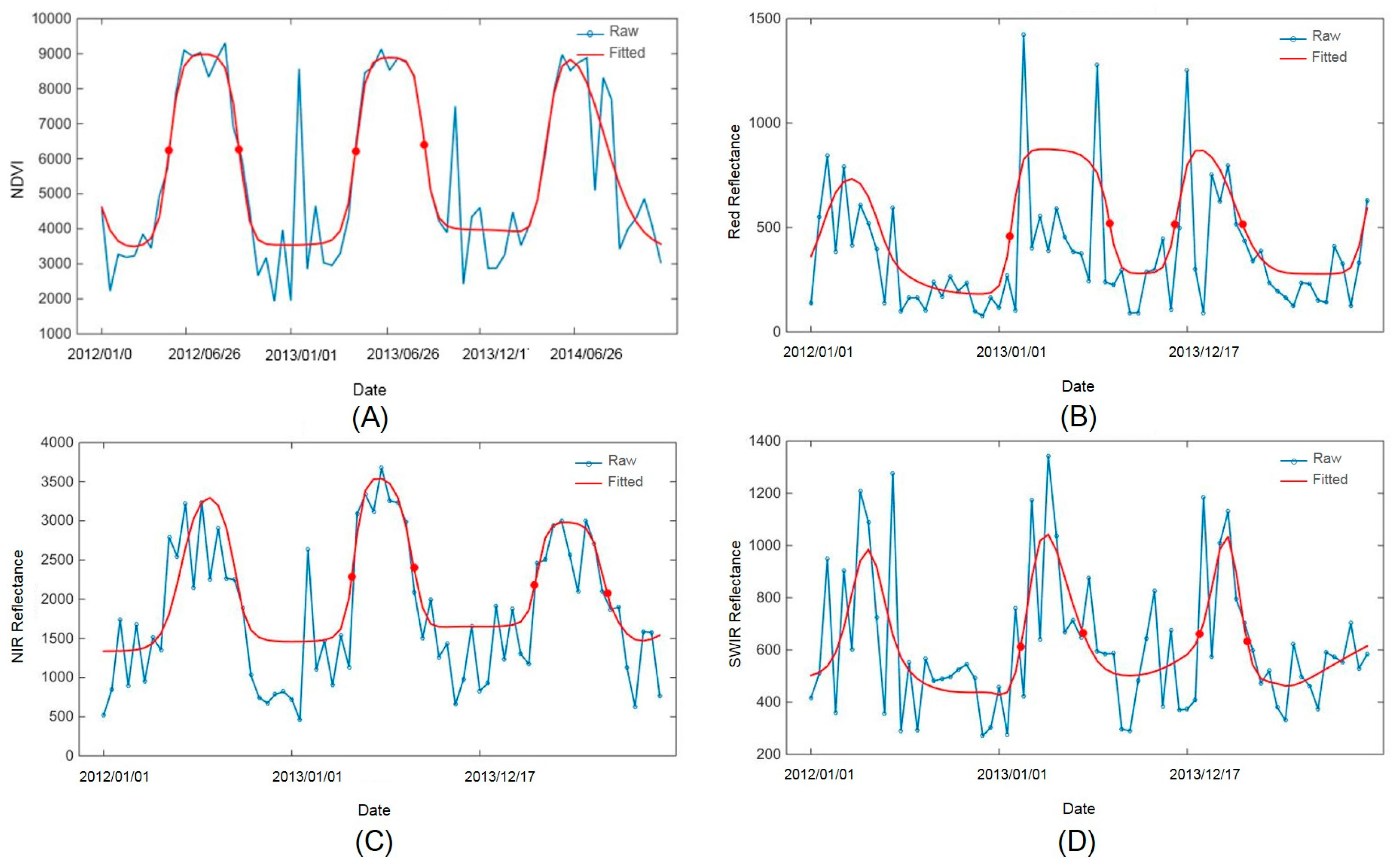
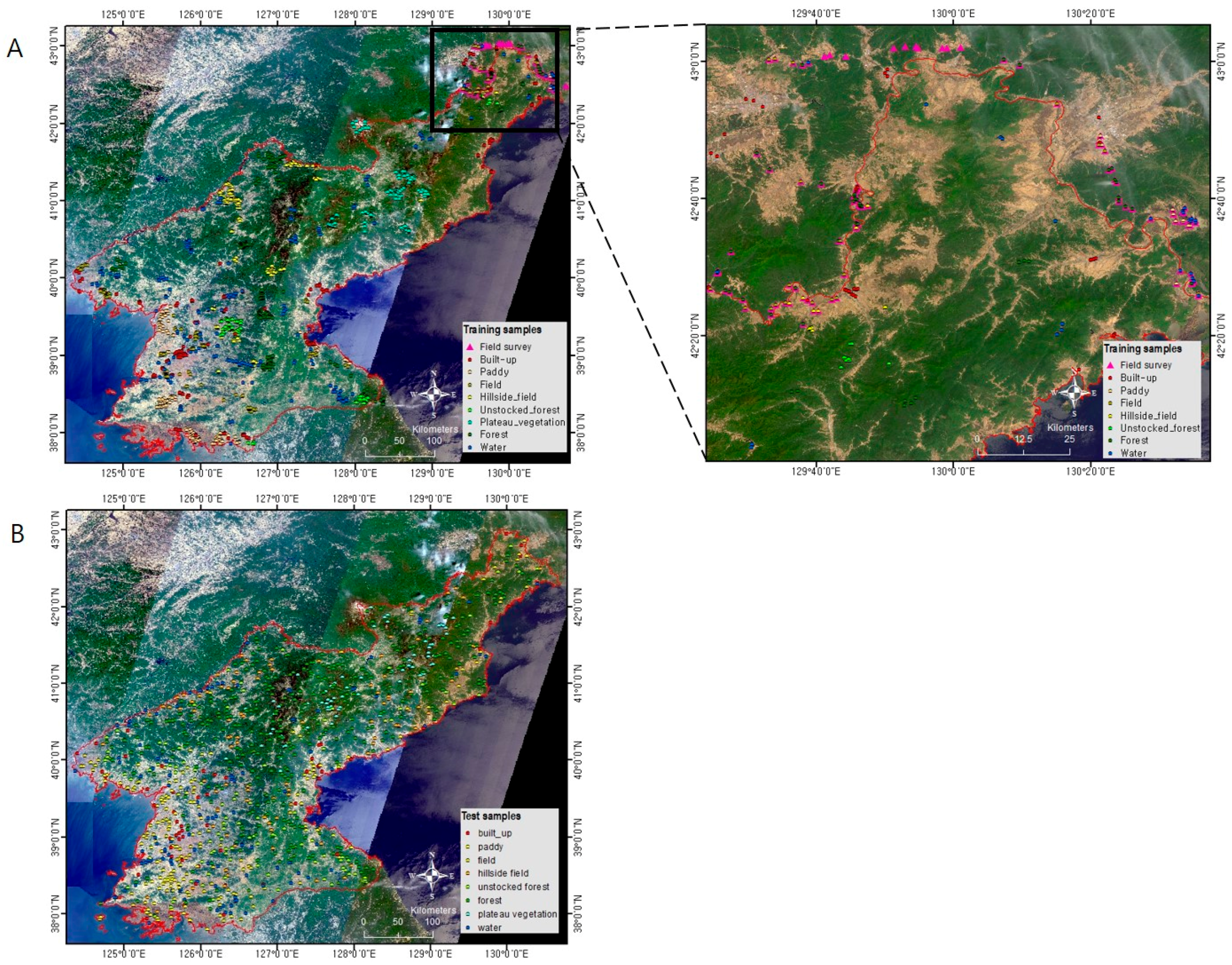
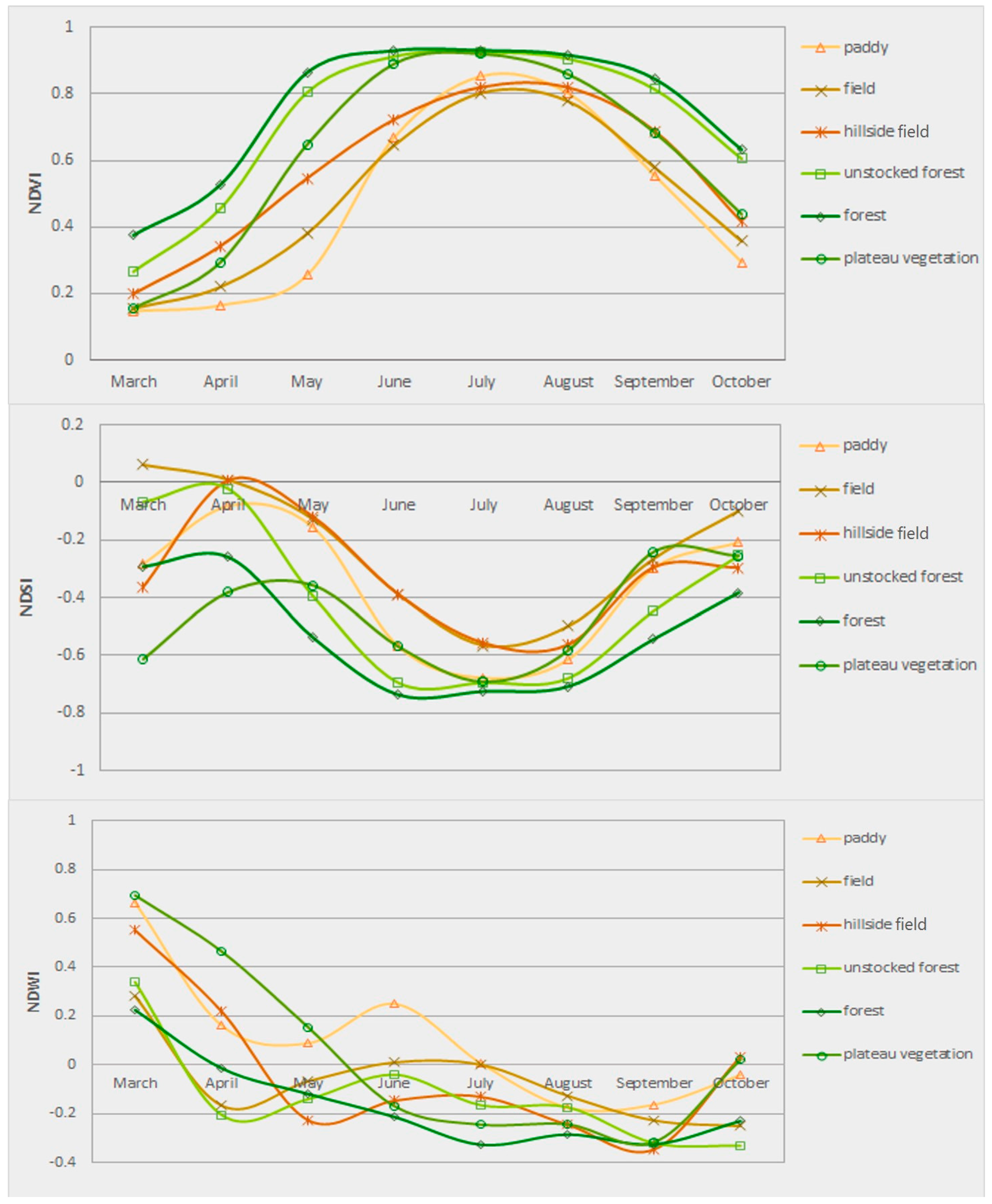
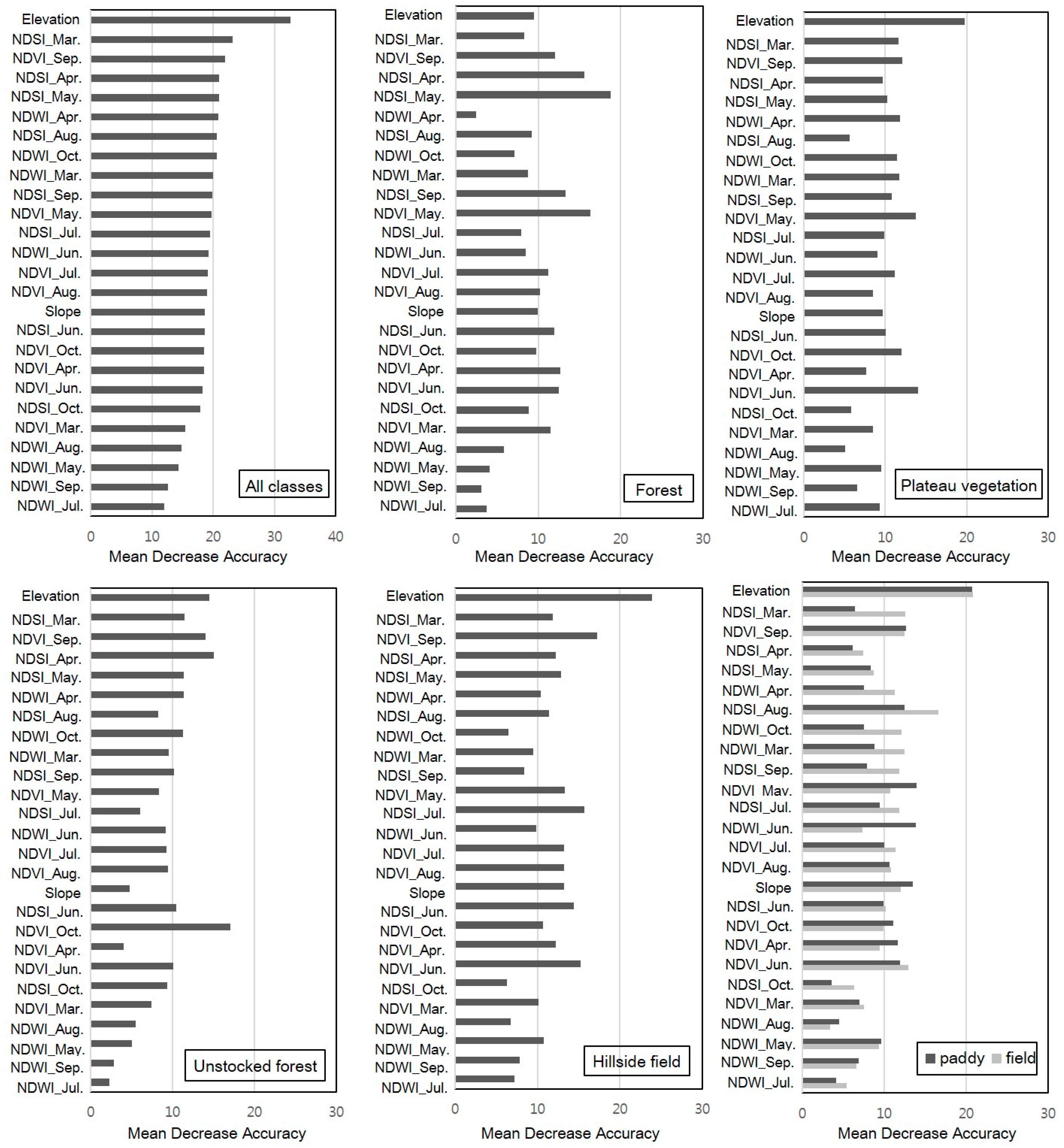
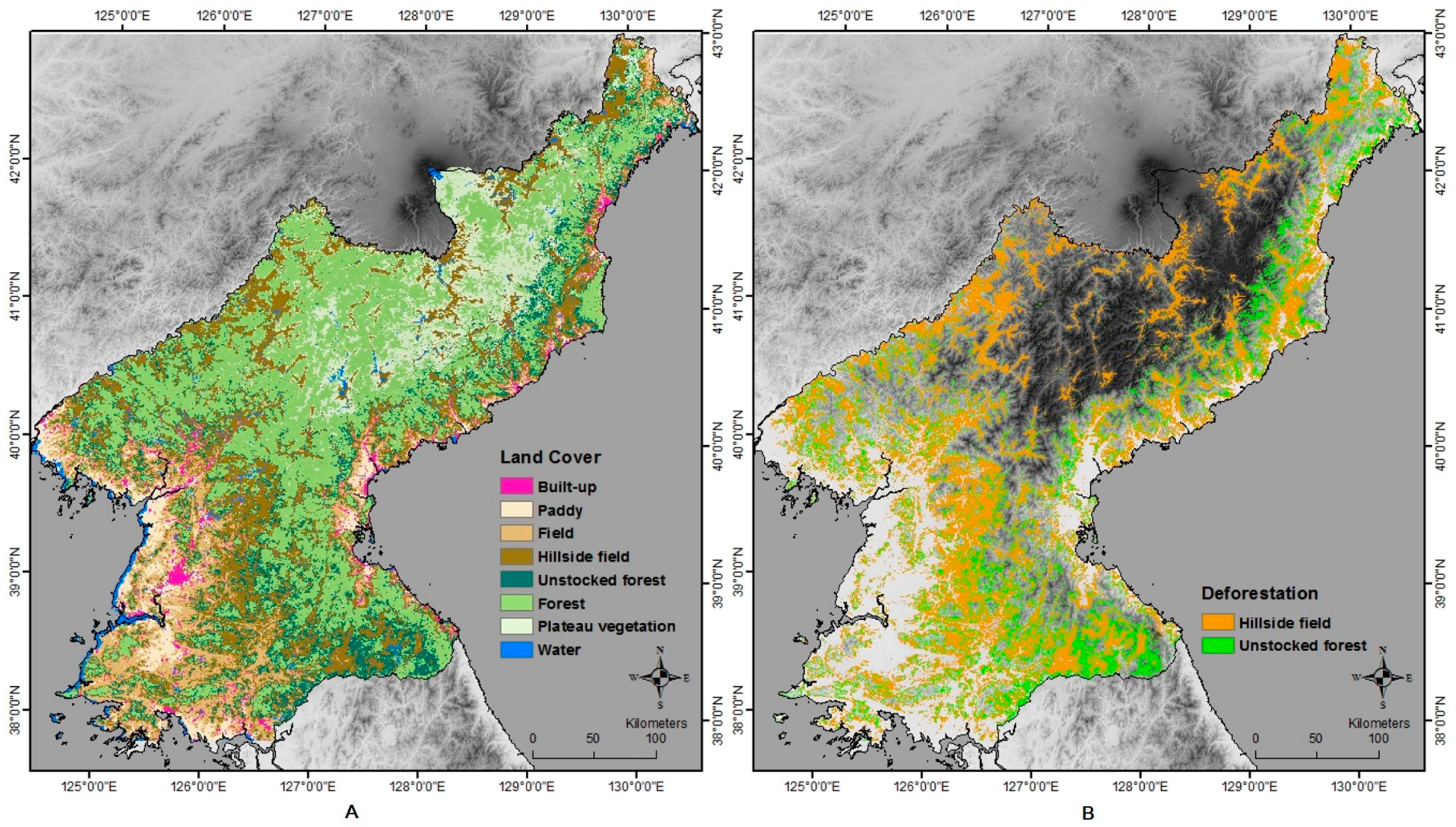
| Class | Description |
|---|---|
| Built up | Urban and buildings. |
| Waterbody | Lakes, reservoirs and rivers. |
| Paddy | Flooded field used to cultivate rice. |
| Field | Crop field with annual crops on flatland. This can be distinguished from paddy or other landscapes by the characteristics of plow lines, rectilinear shapes. |
| Hillside field | Crop field with annual crops on the hillside. It can be detected by 3D view in Google Earth that offers elevation information. |
| Unstocked forest | This class is covered with shrubs or grasses, where crown cover of trees has fallen to <20% because of slash and burn. This class can be confused with hillside field, but it can be detected by the texture and whether there are plow lines or not. |
| Natural forest | Trees are the major components. |
| Plateau vegetation | This class is covered with shrubs or grasses. It can be detected by elevation information and the distribution information from advanced research. |
| Built-up | Paddy | Field | Hillside Field | Unstocked Forest | Forest | Plateau Vegetation | Water | Total | User’s | |
|---|---|---|---|---|---|---|---|---|---|---|
| Built-up | 51 | 0 | 4 | 0 | 0 | 0 | 0 | 2 | 57 | 89.5% |
| Paddy | 0 | 79 | 15 | 3 | 0 | 0 | 0 | 3 | 100 | 79% |
| Field | 0 | 1 | 90 | 8 | 0 | 0 | 0 | 0 | 99 | 90.9% |
| Hillside field | 0 | 0 | 0 | 94 | 1 | 0 | 5 | 0 | 100 | 94% |
| Unstocked forest | 0 | 0 | 0 | 7 | 93 | 2 | 0 | 0 | 102 | 91.2% |
| Forest | 0 | 0 | 0 | 0 | 12 | 329 | 6 | 0 | 347 | 94.8% |
| Plateau vegetation | 0 | 0 | 0 | 0 | 0 | 8 | 69 | 1 | 78 | 88.5% |
| Water | 15 | 1 | 3 | 5 | 1 | 4 | 0 | 87 | 116 | 75% |
| Total | 66 | 81 | 112 | 117 | 107 | 343 | 80 | 93 | 999 | |
| Producer’s | 77.3% | 96.3% | 80.4% | 80.3% | 87% | 96% | 86.3% | 93.5% |
© 2016 by the authors; licensee MDPI, Basel, Switzerland. This article is an open access article distributed under the terms and conditions of the Creative Commons Attribution (CC-BY) license (http://creativecommons.org/licenses/by/4.0/).
Share and Cite
Jin, Y.; Sung, S.; Lee, D.K.; Biging, G.S.; Jeong, S. Mapping Deforestation in North Korea Using Phenology-Based Multi-Index and Random Forest. Remote Sens. 2016, 8, 997. https://doi.org/10.3390/rs8120997
Jin Y, Sung S, Lee DK, Biging GS, Jeong S. Mapping Deforestation in North Korea Using Phenology-Based Multi-Index and Random Forest. Remote Sensing. 2016; 8(12):997. https://doi.org/10.3390/rs8120997
Chicago/Turabian StyleJin, Yihua, Sunyong Sung, Dong Kun Lee, Gregory S. Biging, and Seunggyu Jeong. 2016. "Mapping Deforestation in North Korea Using Phenology-Based Multi-Index and Random Forest" Remote Sensing 8, no. 12: 997. https://doi.org/10.3390/rs8120997
APA StyleJin, Y., Sung, S., Lee, D. K., Biging, G. S., & Jeong, S. (2016). Mapping Deforestation in North Korea Using Phenology-Based Multi-Index and Random Forest. Remote Sensing, 8(12), 997. https://doi.org/10.3390/rs8120997





